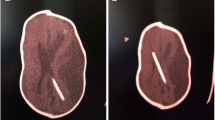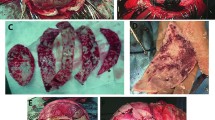Abstract
Introduction
Management of ventriculomegaly in pediatric patients with syndromic craniosynostosis (SC) requires understanding the underlying mechanisms that cause increased intracranial pressure (ICP) and the role of cerebrospinal fluid (CSF) in cranial vault expansion in order to select the best treatment option for each individual patient.
Methods
A total of 33 pediatric patients with SC requiring craniofacial surgery were retrospectively evaluated. Cases of nonsyndromic craniosynostosis and shunt-induced craniosynostosis were excluded. Six syndrome-based categories were distinguished: Crouzon syndrome, Pfeiffer syndrome, Apert syndrome, cloverleaf skull syndrome, and others (Muenke syndrome, Sensenbrenner syndrome, unclassified). All of the patients were treated surgically for their cranial deformity between 2010 and 2016. The presence of ventriculomegaly and ventriculoperitoneal (VP) shunt requirement with its impact in cranial vault expansion were analyzed. Clinical and neuroimaging studies covering the time from presentation through the follow-up period were revised. The mean postoperative follow-up was 6 years and 3 months. A systematic review of the literature was conducted through a PubMed search.
Results
Of the total of 33 patients with SC, 18 (54.5%) developed ventriculomegaly and 13 (39.4%) required ventriculoperitoneal (VP) shunt placement. Six patients (18.2%) required shunt placement previous to craniofacial surgery. Seven patients (21.2%) required a shunt after craniofacial surgery. Seven fixed pressure ventriculoperitoneal shunts and six programmable valves were placed as first choice. All patients improved their clinical symptoms after shunt placement. Aesthetic results seemed to be better in patients with programmable shunts.
Conclusions
Unless clear criteria for overt hydrocephalus are present, it is recommended to perform craniofacial surgery as a first step in the management of patients with SC in order to preserve the expansive effect of CSF for cranial vault expansion. In our experience, the use of externally programmable valves allows for the treatment of hydrocephalus while maintaining the expansive effect of CSF for the remodeling of the cranial vault. Prospective evaluations are needed to determine causality.





Similar content being viewed by others
Data availability
The authors affirm that all data and materials comply with field standards.
References
Agochukwu NB, Solomon BD, Muenke M (2012) Impact of genetics on the diagnosis and clinical management of syndromic craniosynostosis. Childs Nerv Syst 28(9):1447–1463 https://www.ncbi.nlm.nih.gov/pmc/articles/PMC4101189/
Baird L, Gonda D, Cohen S et al (2012) Craniofacial reconstruction as a treatment for elevated intracranial pressure. Childs Nerv Syst 28:411–418 https://www.ncbi.nlm.nih.gov/pubmed/22068642
Borgesen S, Gjerris F (1987) Relationships between intracranial pressure, ventricular size and resistance to CSF outflow. J Neurosurg 67:535–539 https://www.ncbi.nlm.nih.gov/pubmed/3655891
Chang H, Nagakawa H (2003) Hypothesis in the pathophysiology of syringomyelia based on simulation of cerebrospinal fluid dynamics. J Neurol Neurosurg Psychiatry 74(3):344–347 https://www.ncbi.nlm.nih.gov/pubmed/12588922
Cinalli G, Renier D, Sebag G et al (1995) Chronic tonsillar herniation in Crouzon’s and Apert’s syndromes: the role of premature synostosis of the lambdoid suture. J Neurosurg 83:575–582 https://www.ncbi.nlm.nih.gov/pubmed/7674004
Cinalli G, Saint-Rose C et al (1998) Hydrocephalus and craniosynostosis. J Neurosurg 88:209–214 https://www.ncbi.nlm.nih.gov/pubmed/9452225
Coll G, Arnaud E, Selek L et al (2012) The growth of the foramen magnum in Crouzon syndrome. Childs Nerv Syst 28:1525–1535 https://www.ncbi.nlm.nih.gov/pubmed/22872269
Coll G, Abed Rabbo F, Jecko V, Sakka L, Di Rocco F, Delion M (2019) The growth of the posterior cranial fossa in FGFR2-induced faciocraniosynostosis: a review. Neurochirurgie. 65(5):221–227
Coll G, El Ouadih Y, Abed Rabbo F, Jecko V, Sakka L, Di Rocco F (2019) Hydrocephalus and Chiari malformation pathophysiology in FGFR2-related faciocraniosynostosis: a review. Neurochirurgie. 65(5):264–268
Collmann H, Sorensen N, Kraub J (2005) Hydrocephalus in craniosynostosis: a review. Childs Nerv Syst 31:902–912 https://www.ncbi.nlm.nih.gov/pubmed/15864600
Costa M, Ackerman L, Tholpady S et al (2015)Spring-assisted cranial vault expansion in the setting of multisutural craniosynostosis and anomalous venous drainage: case report. JNS Pediatrics 1:80–85. https://doi.org/10.3171/2014.12.PEDS14604
Di Rocco F, Jucá CE, Arnaud E et al (2010) The role of endoscopic third ventriculostomy in the treatment of hydrocephalus associated with faciocraniosynostosis. J Neurosurg Pediatrics 6:17–22 https://www.ncbi.nlm.nih.gov/pubmed/20593982
Eide PK (2003) The relationship between intracranial pressure and size of cerebral ventricles assessed by computed tomography. Acta Neurochir 145:171–179 https://www.ncbi.nlm.nih.gov/pubmed/12632112
Esparza J, Hinojosa J, García Recuero I et al (2008) Surgical treatment of isolated and syndromic craniosynostosis. Results and complications in 283 consecutive cases. Neurocirugía (Astur) 19:509–529 https://www.ncbi.nlm.nih.gov/pubmed/19112545
Fearon JA (2019) Discussion: onset and resolution of Chiari malformations and hydrocephalus in syndromic craniosynostosis following posterior vault distraction. Plast Reconstr Surg 144(4):941–942
Fishman M, Hogan G, Dodge P (1971) The concurrence of hydrocephalus and craniosynostosis. J Neurosurg 34(5):621–629 https://www.ncbi.nlm.nih.gov/pubmed/4326640
Frassanito P, Palombi D, Tamburrini G (2021) Craniosynostosis and hydrocephalus: relevance and treatment modalities. Childs Nerv Syst. https://doi.org/10.1007/s00381-021-05158-z
Golinko MS, Atwood DN, Ocal E (2018) Surgical management of craniosynostosis in the setting of a ventricular shunt: a case series and treatment algorithm. Childs Nerv Syst 34(3):517–525 https://www.ncbi.nlm.nih.gov/pubmed/29110198
Goodrich JT, Tepper O, Staffenberg DA (2012) Craniosynostosis: posterior two-third cranial vault reconstruction using bioresorbable plates and PDS suture lattice in sagittal and lambdoid synostosis. Childs Nerv Syst 28(9):1399–1406 https://www.ncbi.nlm.nih.gov/pubmed/22872255
Hayward R (2005 Oct) Venous hypertension and craniosynostosis. Childs Nerv Syst 21(10):880–888
Henderson D, Budu A, Zaki H et al (2020) A comparison between flow-regulated and adjustable valves used in hydrocephalus during infancy. Childs Nerv Syst 36(9):2013–2019. https://doi.org/10.1007/s00381-020-04552-3
Khanna P, Thapa M, Lyer R et al (2011) Pictorial essay: the many faces of craniosynostosis. Indian J Radiol Imaging 21(1):49–56 https://www.ncbi.nlm.nih.gov/pubmed/21431034
Lin LO, Zhang RS, Hoppe IC, Paliga JT, Swanson JW, Bartlett SP, Taylor JA (2019 Oct) Onset and resolution of Chiari malformations and hydrocephalus in syndromic craniosynostosis following posterior vault distraction. Plast Reconstr Surg 144(4):932–940
Nowinski D, Di Rocco F et al (2012) Posterior cranial vault expansion in the treatment of craniosynostosis. Comparison of current techniques. Child Nerv Syst 28:1537–1544 https://www.ncbi.nlm.nih.gov/pubmed/22872270
Padayachi LC (2016)Non-invasive intracranial pressure assessment. Childs Nerv Syst 32(9):1587–1597. https://doi.org/10.1007/s00381-016-3159-2https://pubmed.ncbi.nlm.nih.gov/27444289/
Passi N, Degnan AJ, Levy LM (2013) MR imaging of papilledema and visual pathways: effects of increased intracranial pressure and pathophysiologic mechanisms. AJNR Am J Neuroradiol 34(5):919–924. https://doi.org/10.3174/ajnr.A3022
Pattisapu J, Gegg C, Olavarria G et al (2010) Craniosynostosis: diagnosis and surgical management. Atlas Oral and Maxillofacial Surg Clin North Am 18:77–91 https://www.ncbi.nlm.nih.gov/pubmed/21036311
Saint-Rose C, LaCombde J et al (1984) Intracranial venous sinus hypertension: cause or consequence of hydrocephalus in infants? J Nuerosurg 60:727–736 https://www.ncbi.nlm.nih.gov/pubmed/6707742
Schijman E (2004) History, anatomic forms, and pathogenesis of Chiari I malformations. Childs Nerv Syst 20:323–328 https://www.ncbi.nlm.nih.gov/pubmed/14762679
Schirmer CM, Hedges TR (2007) Mechanisms of visual loss in papilledema. Neurosurg Focus FOC 23(5): E5. https://doi.org/10.3171/FOC-07/11/E5 https://thejns.org/focus/view/journals/neurosurg-focus/23/5/foc-07_11_e5.xml
Sprujit B, Tasker RC, Driessen C et al (2016) Abnormal transcranial Doppler cerebral blood flow velocity and blood pressure profiles in children with syndromic craniosynostosis and papilledema. J Craniomaxillofac Surg 44:465–470 https://www.ncbi.nlm.nih.gov/pubmed/26857754
Tamburrini G, Caldarelli M, Massimi L et al (2012) Complex craniosynostoses: a review of the prominent clinical features and the related management strategies. Childs Nerv Syst 28:1511–1523 https://www.ncbi.nlm.nih.gov/pubmed/22872268
Thiele-Nygaard AE, Foss-Skiftesvik J, Juhler M (2020) Intracranial pressure, brain morphology and cognitive outcome in children with sagittal craniosynostosis. Childs Nerv Syst 36(4):689–695. https://doi.org/10.1007/s00381-020-04502-z
Thomale UW, Gebert AF, Haberl H, Schulz M (2013) Shunt survival rates by using the adjustable differential pressure valve combined with a gravitational unit (proGAV) in pediatric neurosurgery. Childs Nerv Syst 29(3):425–431. https://doi.org/10.1007/s00381-012-1956-9
Won Choi J, Young Lim S, Shin HJ (2016) Craniosynostosis in growing children: pathophysiological changes and neurosurgical problems. J Korean Neurosurg Soc 59(3):197–203 https://www.ncbi.nlm.nih.gov/pmc/articles/PMC4877540
Yadav Y, Mukerji G et al (2009) Complex hydrocephalus (combination of communicating and obstructive type): an important cause of failed endoscopic third ventriculostomy. BMC Research Notes 2:137 https://bmcresnotes.biomedcentral.com/articles/10.1186/1756-0500-2-137
Yadav Y, Parihar V et al (2012) Endoscopic third ventriculostomy. J Neurosci Rural Pract 3(2):163–173 https://www.ncbi.nlm.nih.gov/pmc/articles/PMC3409989
Code availability
Not applicable.
Author information
Authors and Affiliations
Corresponding author
Ethics declarations
Ethics approval
This is a retrospective observational study. The Research Ethics Committee of the Hospital de Pediatría SAMIC “Prof. Dr. Juan P. Garrahan” has confirmed that no ethical approval is required.
Consent to participate
Not applicable.
Consent for publication
The authors affirm that human research participants provided informed consent for publication of the images in Figs. 1, 2, 3, 4, and 5.
Conflict of interest
The authors declare no competing interests.
Additional information
Publisher’s note
Springer Nature remains neutral with regard to jurisdictional claims in published maps and institutional affiliations.
This article is part of the Topical Collection on Pediatric Neurosurgery
Rights and permissions
About this article
Cite this article
Tcherbbis Testa, V., Jaimovich, S., Argañaraz, R. et al. Management of ventriculomegaly in pediatric patients with syndromic craniosynostosis: a single center experience. Acta Neurochir 163, 3083–3091 (2021). https://doi.org/10.1007/s00701-021-04980-3
Received:
Accepted:
Published:
Issue Date:
DOI: https://doi.org/10.1007/s00701-021-04980-3




